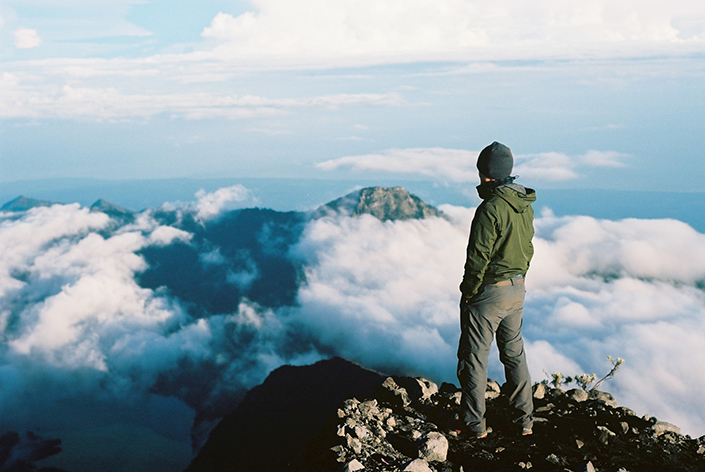
Introduction to Mount Rinjani
Towering majestically at 3,726 meters (12,224 feet) above sea level, Mount Rinjani stands as Indonesia’s second-highest volcano and one of Southeast Asia’s most spectacular natural wonders. Located on Lombok Island, just east of Bali, this active volcano offers one of the most rewarding trekking experiences in the entire archipelago. The Mount Rinjani trekking adventure attracts thousands of adventurers annually who come to challenge themselves on its slopes while witnessing some of the most awe-inspiring scenery imaginable.
What makes Rinjani truly special is its diverse ecosystem and the dramatic caldera that houses the crescent-shaped Segara Anak Lake. This stunning turquoise lake, formed after a massive eruption in the 13th century, is considered sacred by the local Sasak and Balinese people who make pilgrimages to its shores. Within the lake itself rises a young, active cone called Gunung Baru (New Mountain), adding another layer to this geological marvel.
Historical and Cultural Significance
Before delving into the practicalities of Mount Rinjani trekking, it’s important to understand the cultural significance this mountain holds. For centuries, Rinjani has been revered as a place of spiritual power. According to local beliefs, the name “Rinjani” derives from an old Javanese term “Ri Anjani,” referring to “The Mountain of God.”
The local Sasak people believe the crater lake is home to spirits, while Balinese Hindus consider it a dwelling place of deities. Each year, religious ceremonies take place at the lake, with devotees bringing offerings and seeking blessings. Understanding this cultural context enriches the trekking experience, allowing visitors to appreciate the mountain beyond its physical beauty.
Archaeological evidence suggests human activity around Rinjani dates back several centuries, with ancient inscriptions and artifacts found in caves and around the caldera. The mountain has witnessed the rise and fall of kingdoms, survived numerous eruptions, and continues to shape the identity of Lombok Island.
Planning Your Mount Rinjani Trekking Experience
Best Time to Visit
Timing is crucial for a successful Mount Rinjani trekking expedition. The official climbing season typically runs from April to November, with the prime months being July and August. During these months, you can expect dry weather, clear skies, and optimal visibility—perfect conditions for both trekking and photography.
The wet season (November to March) brings significant rainfall, making trails slippery and dangerous. During this period, the national park authorities often close the mountain to visitors due to safety concerns. Even during the dry season, weather conditions can change rapidly, with temperatures at the summit dropping to near freezing at night.
According to park statistics, July witnesses the highest number of trekkers, with over 5,000 visitors attempting the climb. If you prefer a less crowded experience, consider trekking in April, May, September, or October when conditions remain favorable but visitor numbers are significantly lower.
Physical Preparation
Mount Rinjani trekking is not for the faint-hearted. The trails are steep, often loose with volcanic scree, and require good physical conditioning. Experts recommend preparing for at least two months before your trip with:
- Regular cardiovascular exercise (running, swimming, or cycling)
- Strength training focusing on legs and core
- Practice hikes on steep terrain carrying a daypack
- Endurance training to build stamina for long hiking days
A 2019 survey of trekkers revealed that 65% rated the difficulty as “challenging to severe,” with the summit push being the most demanding segment. However, with proper preparation, determination, and a positive attitude, the trek is achievable for most reasonably fit individuals.
Essential Gear and Equipment
Your equipment can make or break your Mount Rinjani trekking experience. While organized tours typically provide camping gear, you’ll need to bring personal items such as:
- Sturdy hiking boots with ankle support (well broken-in)
- Layered clothing suitable for temperatures ranging from 30°C (86°F) at the base to 0°C (32°F) at the summit
- Waterproof jacket and rain cover for backpack
- Headlamp with extra batteries
- Sunscreen, hat, and sunglasses
- First aid kit including blister treatment
- Trekking poles for steep descents
- Water purification tablets or filter
- Camera with extra batteries (you’ll want to capture the incredible vistas)
Research shows that inadequate footwear is the number one cause of injuries during the trek, followed by insufficient water and inappropriate clothing. Don’t compromise on essential equipment.
Popular Trekking Routes
The Senaru Route
The Senaru route, beginning from the northern side of the mountain, is often considered the more scenic and gradual approach. This path takes trekkers through dense tropical forests teeming with rare black monkeys, exotic birds, and lush vegetation before emerging above the tree line to reveal spectacular panoramic views.
The typical itinerary spans three days and two nights, with the first day covering approximately 8 kilometers from Senaru village (601m) to Position 2 camp (2,000m). Day two involves reaching the rim of the caldera, descending to Segara Anak Lake for a refreshing dip in the hot springs, and camping by the lake. The final day includes the climb back up to the rim and descent to Senaru village.
The Senaru trail showcases Rinjani’s incredible biodiversity, with over 22 species of birds and 15 mammal species that call this ecosystem home. The transition from tropical forest to alpine environment provides trekkers with a fascinating glimpse into ecological zonation.
The Sembalun Route
For those prioritizing the summit attempt, the Sembalun route starting from the eastern side offers the more direct path to Rinjani’s peak. Beginning at the higher elevation of Sembalun village (1,156m), this trail crosses open grasslands and savannahs before tackling the steeper sections.
The standard three-day itinerary includes camping at Position 3 (2,639m) on the first night, summiting at sunrise on the second day, then descending to the lake for the second night. The final day involves climbing back up to the rim and descending to Sembalun village.
This route offers stunning views of East Lombok’s agricultural landscapes and provides the most direct summit access. However, the open terrain means less shade and more exposure to the elements. According to park records, approximately 70% of summit attempts occur via this route due to its more direct approach.
The Circular Route
For the most comprehensive experience, many trekkers opt for the circular route, ascending via one path and descending via the other. This four-day, three-night journey allows trekkers to experience all of Rinjani’s major attractions: the summit, the lake, the hot springs, and both the forest and savannah ecosystems.
While more time-consuming, this route maximizes the Mount Rinjani trekking experience and reduces environmental impact by distributing foot traffic across different trails. Environmental researchers have noted that this approach helps mitigate erosion and trail degradation compared to out-and-back routes.
Experiencing Mount Rinjani’s Highlights
The Summit Adventure
Reaching Rinjani’s summit is the crowning achievement for most trekkers. The push typically begins around 2:00 AM to reach the peak for sunrise—a challenging 3-4 hour climb in darkness over loose volcanic scree. The effort is immensely rewarding when dawn breaks, revealing what National Geographic once described as “one of Southeast Asia’s most spectacular sunrise viewpoints.”
From the summit, the panorama encompasses Lombok in its entirety, neighboring Bali with its Mount Agung, Sumbawa Island to the east, and the vast expanse of the Indonesian archipelago stretching toward the horizon. On exceptionally clear days, even the faint outline of Mount Tambora on Sumbawa (site of history’s largest volcanic eruption) can be spotted.
Segara Anak Lake and Hot Springs
The 6-kilometer-wide caldera houses the mesmerizing Segara Anak Lake, whose turquoise waters create a striking contrast against the black volcanic sand and lush surrounding vegetation. The lake covers approximately 11 square kilometers and reaches depths of over 200 meters.
After the rigorous trekking, the natural hot springs near the lake offer welcome relief for tired muscles. These sulfur-rich waters, heated by the mountain’s geothermal activity, maintain temperatures between 40-45°C (104-113°F) and are believed to have therapeutic properties. Many trekkers report the hot springs soak as one of their most memorable experiences during the Mount Rinjani trekking journey.
Flora and Fauna Encounters
The mountain hosts remarkable biodiversity across its various elevation zones. The lower slopes feature tropical forests with orchids, ferns, and hardwoods like mahogany. As altitude increases, the vegetation transitions to casuarina forests and eventually alpine shrubs near the summit.
Wildlife enthusiasts might spot the rare ebony leaf monkey, long-tailed macaques, barking deer, and numerous bird species including the endangered Rinjani scops owl. The Rinjani conservation area serves as a critical habitat for these species, with ongoing research highlighting the mountain’s importance as a biodiversity hotspot.
Responsible Trekking Practices
As Mount Rinjani trekking grows in popularity, environmental concerns have emerged. The influx of visitors has led to trail erosion, waste management issues, and disruption to wildlife. Responsible trekkers can help preserve this natural wonder by:
- Adhering to “leave no trace” principles
- Using authorized guides and tour operators who follow sustainable practices
- Carrying out all non-biodegradable waste
- Respecting wildlife by maintaining distance and not feeding animals
- Minimizing water usage at camps
- Supporting local conservation initiatives
Environmental organizations report that each year, volunteer cleanup expeditions remove over five tons of waste from Rinjani’s slopes. By practicing responsible tourism, visitors ensure future generations can also experience the magic of Mount Rinjani trekking.
Practical Tips for a Successful Trek
Guides and Permits
Regulations require all foreign trekkers to be accompanied by licensed guides. This policy not only ensures safety but also provides employment for local communities. Guides typically cost between $30-50 per day, with packages including porters, equipment, food, and permits.
All trekkers must obtain permits from the Mount Rinjani National Park office, with fees contributing to conservation efforts and trail maintenance. Current fees are approximately IDR 150,000 ($10) per person for foreigners, though these rates are subject to change.
Accommodation Options
Most Mount Rinjani trekking experiences involve camping, with tents typically provided by tour operators. For pre and post-trek stays, both Senaru and Sembalun villages offer accommodation ranging from basic homestays ($10-20 per night) to more comfortable lodges ($30-80 per night).
Local Cuisine and Water Sources
Part of the Rinjani experience is enjoying meals prepared by your trekking team. These typically feature Indonesian staples like nasi goreng (fried rice), mie goreng (fried noodles), and fresh tropical fruits. Vegetarian options can be arranged with advance notice.
Water sources exist along the routes, particularly at the lake, but all water should be purified before consumption. Most guides boil water for trekkers, but bringing purification tablets as backup is advisable.
Conclusion
Mount Rinjani trekking represents one of Southeast Asia’s most rewarding adventures—a perfect blend of physical challenge, natural beauty, and cultural immersion. Whether you’re watching the sunrise paint gold across the archipelago from the summit, soaking in therapeutic hot springs beside a crater lake, or sharing stories with fellow trekkers under star-filled skies, Rinjani offers experiences that linger in memory long after the journey ends.
The mountain’s timeless presence has inspired human wonder for centuries, and today’s trekkers join a long lineage of those who have challenged themselves on its slopes. With proper preparation, respect for local customs, and commitment to environmental stewardship, your Mount Rinjani trekking adventure awaits—promising not just spectacular photographs, but a transformative journey that connects you with nature at its most magnificent.


